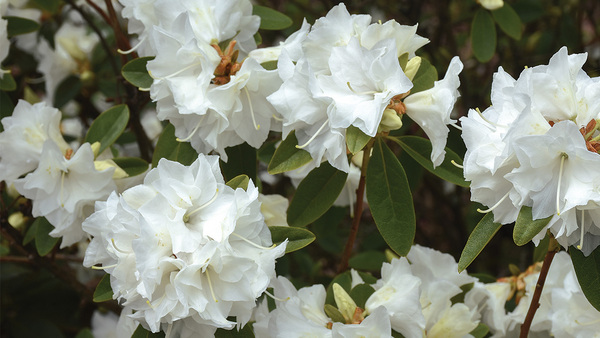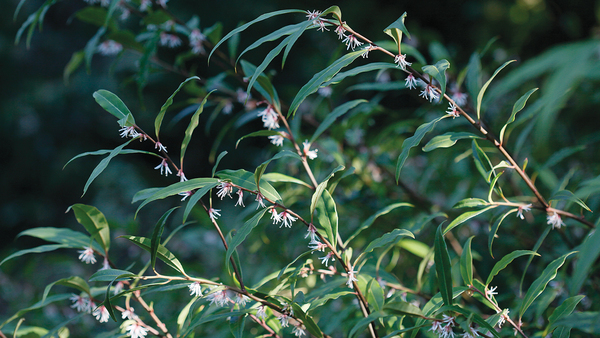
In an episode of Fine Gardening‘s podcast, Let’s Argue About Plants, the hosts discuss the importance of evergreen plants, and the particular perks of broadleaf evergreens:
“The key to any successful four-season garden is evergreens. Conifers are great, but they can be pricey and slow to bulk up. Broadleaf evergreens, on the other hand, bulk up quickly and are generally affordable. The only drawback is they can be boring. In fact, most gardeners think only of rhodies and hollies when it comes to this classification of plants.”
Don’t be fooled by the common varieties, there is much more to this plant category than one might think while walking around the local garden center. To help shed light on some fabulous, underappreciated broadleaf evergreens, we had regional experts pick their top four. Below, you’ll find great picks for California. To discover more fantastic evergreens, check out LAAP Episode 26: Broadleaf Evergreens.
Find broadleaf evergreens for other regions: Interesting Broadleaf Evergreens for Your Region

1. ‘Jelly Bean Orange’ monkeyflower
Name: Mimulus aurantiacus ‘Jelly Bean Orange’
Zones: 9–11
Size: 2 feet tall and wide
Conditions: Full sun to partial shade; dry, well-drained soil
Native range: Southern Oregon, California, Baja California
‘Jelly Bean Orange’ monkeyflower is a small nativar with an upright, rounded, and compact habit. This fast-growing plant has dark green, glossy leaves that are somewhat sticky, and numerous dark orange, ruffled flowers that bloom nearly year-round. It can take full sun on the coast but prefers partial shade inland. ‘Jelly Bean Orange’ is reliably showy in infertile soil and is perfect for rock gardens as well as containers. It’s deer and fire resistant and attracts many hummingbirds, butterflies, and other pollinators. Once established, monkeyflower does best with an occasional deep watering in summer. Pinch it back occasionally to help it form a good branching structure to support the flowers.

2. ‘Paradise’ manzanita
Name: Arctostaphylos pajaroensis ‘Paradise’
Zones: 8–10
Size: 6 to 8 feet tall and 6 to 10 feet wide
Conditions: Full sun to partial shade; well-drained soil
Native range: California
A great selection for a small tree in a water-wise garden, ‘Paradise’ manzanita forms pendulous clusters of urn-shaped flowers that vary from white to pink and that bloom in late winter, providing pollen for overwintering hummingbirds and bees. The red berries that follow are eaten by many bird species. The bark is also a dark red, set against blue-green, deer-resistant foliage. ‘Paradise’ manzanita prefers well-drained, acidic soil and needs little water once established. Annual pruning in late fall to early winter will improve looks and performance.

3. ‘Concha’ California lilac
Name: Ceanothus ‘Concha’
Zones: 7–10
Size: 6 to 8 feet tall and 8 to 12 feet wide
Conditions: Full sun to partial shade; average to dry, well-drained soil
Native range: Hybrid of California native species
‘Concha’ California lilac is one of the most striking California nativars to use as an accent plant or a small garden tree. It’s very tolerant of sun and heat but can also be used in dry, dappled shade. In early spring, ‘Concha’ blooms with deep ultramarine-blue flowers. You can use it in background areas for screening, where its seasonal flower display will transform it into a focal feature. Once established, this shrub needs careful summer watering to stay happy. ‘Concha’ is a magnet for birds, butterflies, and hummingbirds but is deer resistant.

4. ‘Tiger Eye’ flowering maple
Name: Abutilon ‘Tiger Eye’
Zones: 9–11
Size: 8 to 10 feet tall and 4 to 5 feet wide
Conditions: Full sun to partial shade; moist, well-drained soil
Native range: Hybrid
Flowering maples are also sometimes called Chinese lanterns for the flowers’ unique shape and the fact that they hang straight down from the branches. ‘Tiger Eye’ can bloom almost nonstop throughout the year if it has shelter from winter frost or harsh direct afternoon sun. If you live in a colder zone, you can easily bring it indoors for winter as long as you provide lots of light. ‘Tiger Eye’ can take some heavy pruning in spring to control the size of the plant or to correct legginess. I have even found that some light pruning throughout the season makes the plant bloom more.
Shireen Zia is the owner of EcoGardens Landscape Design in Los Altos, California.
Click here to find plant picks, garden tips, and more for Northern California.
Fine Gardening Recommended Products

DeWalt Variable-Speed Cordless Reciprocating Saw
Fine Gardening receives a commission for items purchased through links on this site, including Amazon Associates and other affiliate advertising programs.
- 18.31 x 6.13 x 4 inches
- 1-1/8-inch stroke length
- Variable speed trigger with 0-3000 spm

Pruning Simplified: A Step-by-Step Guide to 50 Popular Trees and Shrubs
Fine Gardening receives a commission for items purchased through links on this site, including Amazon Associates and other affiliate advertising programs.

ARS Telescoping Long Reach Pruner
Fine Gardening receives a commission for items purchased through links on this site, including Amazon Associates and other affiliate advertising programs.


















Comments
Log in or create an account to post a comment.
Sign up Log in